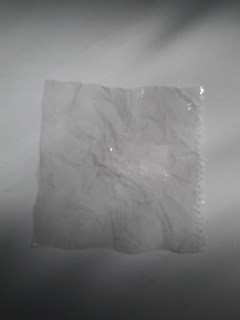You could just root them and put them on their own, but depending on the species, you run a higher risk of running into conditions such as root rot, and they may require more specialized growing mixes and attention to moisture levels (not to mention you will probably notice a diminished growth rate).
So today I am going to show you how to use trichocereus to provide your grafts with a more permenant home. Trichocereus (almost any variety will work) are obviously more physically robust than pereskiopsis, but they are also quite fast growing, and very tolerant in terms of growing medium, sunlight, and moisture levels; don't go treating them like your pereskiopsis, they aren't that tough, but they are still very easy to take care of as far as cactus go.
For this tutorial, I am using a section of Trichocereus Pachanoi that was grown out on pereskiopsis to its current size, approximately 4 inches tall. For the scion, I am using a Discocactus Horstii that was grown on pereskiopsis from a seedling. You will notice in the picture below, that the Pachanoi grafted onto pereskiopsis has been cut back a few times; when you cut off a tip, at least two more replace it, giving you a steady supply of rootstocks. The supplies you will need to do this are the same as those used in "Pereskiopsis Seedling Grafting 101", and the sanitary procedures are the same as well.
After you clean your blade thoroughly with rubbing alcohol, cut the rootstock (Pachanoi in this case) off at its base, and then cut the bottom off so that it is even, and cut as much of the tip off as is necessary to give a solid base for the scion. I also like to cut a small angle off around the top of the rootstock after I remove the tip; this is so that if the edge of either the rootstock or the scion curls in at the union, there will be some extra room so the two wont be forced apart.
You can discard the piece you cut from the bottom, and in an upcoming post I will show you something cool you can do with the top portion, but for now I guess you can throw that away too...So once you have your rootstock prepared, you need to get your scion ready. When I do this, I always make sure to leave a portion attached to the pereskiopsis with plenty of areoles, so that I can get more tips out of it in the future; never degraft completely (unless they are dying or just not producing anymore), because they almost always put out new tips over and over again.
After you have your rootstock and your scion prepared, get yourself a piece of plastic wrap approximately six inches square, and one of those little wires we used when grafting to pereskiopsis. Now, place the scion on top of the rootstock, and center the plastic wrap over it, and then bring the sides down around to the bottom and twist so that the scion and rootstock are forced together firmly, then secure the twisted plastic wrap with the wire, as seen below.
Since the scion and rootstock are of similar diameter, and they have much more developed vascular tissue, placement isn't that big of a worry; just shift the two around until they are more-or-less aligned (like with the seedling grafting, it is best to do this after the wrap is in place and secured). After you have done this just leave it in a cool area to bind together. In my experience, four to seven days is adequate time for this to occur. After this time has passed, carefully remove the plastic wrap, and allow the bottom cut to callus up a bit before planting, just as though you were planting any other cactus cutting. Once a callus has formed, I prefer to plant in a dry cactus soil, and simply give the cactus a few sprays of pure water around its base every other day or so. Remember, the soil needs to be somewhat warm (around 70 degrees Fahrenheit) for good rooting to take place.
There you have it, hope this helps. Stay tuned, we are going to go over some more grafting techniques pretty soon. The weather is warming up too, so we will probably try some outdoor pereskiopsis experiments in the near future.
Subscribe and Comment
Technorati tags: Trichocereus, grafting, Pereskiopsis

























